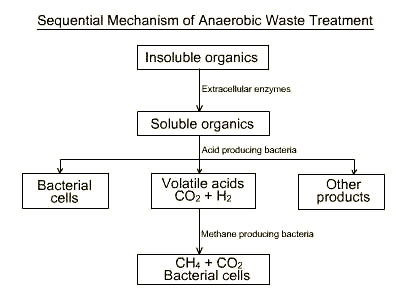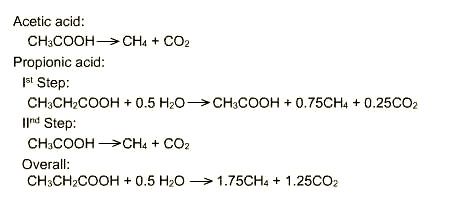Home
Lecture
Quiz
Design Example |
Anaerobic Treatment
Fundamental Microbiology
Anaerobic Treatment
The anaerobic waste treatment process is an effective method for the treatment of many organic wastes. The treatment has a number of advantages over aerobic treatment process, namely,
- the energy input of the system is low as no energy is requred for oxygenation,
- lower production of excess sludge( biological synthesis) per unit mass of substrate utilized,
- lower nutrient requirement due to lower biological synthesis, and
- degradation leads to production of biogas which is a valuable source of energy.
Fundamental Microbiology
The anaerobic treatment of organic wastes resulting in the production of carbon dioxide and methane, involves two distinct stages. In the first stage, complex waste components, including fats, proteins, and polysaccharides are first hydrolyzed by a heterogeneous group of facultative and anaerobic bacteria. These bacteria then subject the products of hydrolysis to fermentations, b-oxidations, and other metabolic processes leading to the formation of simple organic compounds, mainly short-chain (volatile) acids and alcohols. The first stage is commonly referred to as "acid fermentation". However in the second stage the end products of the first stage are converted to gases (mainly methane and carbon dioxide) by several different species of strictly anaerobic bacteria. This stage is generally referred to as "methane fermentation".

The primary acids produced during acid fermentation are propionic and acetic acid. It is reported that only one group of methane bacteria is necessary for methane fermentation of acetic acid, whereas propionic acid, which is fermented through acetic acid requires two different groups of methane bacteria. The methane fermentation reactions for these two acids are: 
The bacteria responsible for acid fermentation are relatively tolerant to changes in pH and temperature and have a much higher rate of growth than the bacteria responsible for methane fermentation. As a result, methane fermentation is generally assumed to be the rate limiting step in anaerobic wastewater treatment.
. |